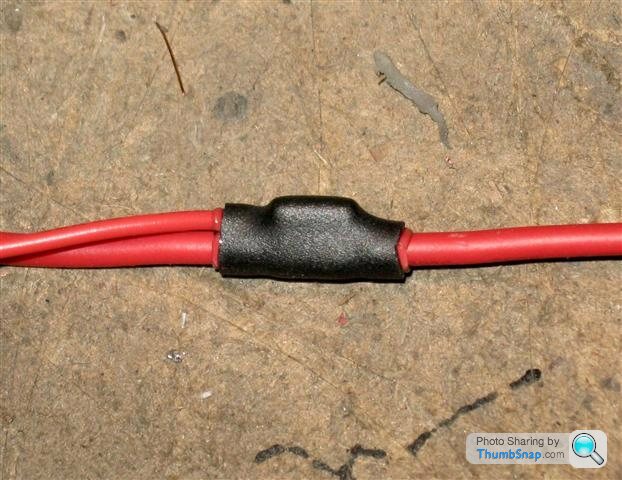Splicing into wiring loom
Discussion
Hi guys,
I am adding a couple of additional gauges to my RX and they will require a 12v feed from the ignition and also from the lights. I can get these from the Radio or dash display loom so that isn't a problem. However what is the best way to splice into an existing cable without cocking it all up?
I am adding a couple of additional gauges to my RX and they will require a 12v feed from the ignition and also from the lights. I can get these from the Radio or dash display loom so that isn't a problem. However what is the best way to splice into an existing cable without cocking it all up?
buzzer said:
CrutyRammers said:
For a couple of additions, solder and heatshrink. Scotchlocks are nasty.
for none critical items Scotchlocks are not bad, especialliy in areas that dont get wet, or are awkward to get to, like the back of a dash... just use the right size for the cable.The OP asked for the best way so others post the worst way
Scotchlocks should not be used for any electrical job, they are only good for lighting fires
Scotchlocks are the spawn of the Devil, and the ultimate bodge.
Man up, and use a double spade connector from an adjacent gauge.
http://www.ebay.co.uk/itm/100-HIGH-TEMPERATURE-PIG...
JOhn
Man up, and use a double spade connector from an adjacent gauge.
http://www.ebay.co.uk/itm/100-HIGH-TEMPERATURE-PIG...
JOhn
finishing touch said:
Another vote against Scotchlocks.
If the wire your fitting them to is fairly thick they almost cut it in half.
Paul G
Not if you use the correct size. I have used them for over 30 years.... In the company i used to work for, we used them a lot, we had 3000 vehicles... We fitted many aftermaket devices. The only problems i ever saw was in areas of high salt saturation. So i wouldnt use them under a wheel arch, but would be happy to use them on say a tow bar instalation.If the wire your fitting them to is fairly thick they almost cut it in half.
Paul G
Fit them right, using the correct size, and they are fine.
I have used a few of these recently...
http://www.ebay.co.uk/itm/2x-Normal-Size-Piggy-Bac...
 REAAOSw3ydVsuZ~
REAAOSw3ydVsuZ~Edited by buzzer on Friday 30th September 09:18
buzzer said:
Not if you use the correct size. I have used them for over 30 years.... In the company i used to work for, we used them a lot, we had 3000 vehicles... We fitted many aftermaket devices. The only problems i ever saw was in areas of high salt saturation. So i wouldnt use them under a wheel arch, but would be happy to use them on say a tow bar instalation.
Fit them right, using the correct size, and they are fine.
I have used a few of these recently...
http://www.ebay.co.uk/itm/2x-Normal-Size-Piggy-Bac... REAAOSw3ydVsuZ~
REAAOSw3ydVsuZ~
Scotchlocks are a quick and easy way to get power from a wire, they are not the "best" solution, based on my experience of them, they create a hotspot in the feed cable, they corrode, they rub and snag and potentially cause short circuits and they are often crimped on incorrectly so the metal inside the connector ends up protruding out of the casing.Fit them right, using the correct size, and they are fine.
I have used a few of these recently...
http://www.ebay.co.uk/itm/2x-Normal-Size-Piggy-Bac...
 REAAOSw3ydVsuZ~
REAAOSw3ydVsuZ~Edited by buzzer on Friday 30th September 09:18
If they were so good then the OEM's would use them in the factory!
Penelope Stopit said:
Very neat but what's going on under the heatshrink? Do all three wire (presume original cable is cut to feed heatshrink on) go into some sort of little receptacle and then all soldered up? cable insulation looks to be melted?Soldering is only "best" if you know how to solder and join is cleaned of all flux afterwards... imho.
While I agree "Scotchloks" are the Devils invention perhaps they are acceptable for very low current circuits? Certainly "in my day" they were the standard for wiring in tow bar sockets

Another variant
phillpot said:
Penelope Stopit said:
Very neat but what's going on under the heatshrink? Do all three wire (presume original cable is cut to feed heatshrink on) go into some sort of little receptacle and then all soldered up? cable insulation looks to be melted?Soldering is only "best" if you know how to solder and join is cleaned of all flux afterwards... imho.
While I agree "Scotchloks" are the Devils invention perhaps they are acceptable for very low current circuits? Certainly "in my day" they were the standard for wiring in tow bar sockets

Another variant
 ks
ksIf soldering is a problem, a splice crimp terminal can be used for low current circuits and can still be heat-shrinked
Scotchlocks are no good for any job and I am surprised they ever reached the european markets
You pay peanuts, you get monkeys working for you, monkeys use Scotchlocks
Penelope Stopit said:
No the insulation isn't melted
Thanks, explains that bit but still not clear what's under the heatshrink, obviously too neat, the wires aren't just twisted together.A quick search on Ebay and a couple of vehicle electrics/wiring suppliers I use for "splice crimp terminal" came up with nothing?
Ditto (as bodge) is soldering, unless you are very good at it.
The heat damages the insulation.
Solder 'wicks' along the cable, making it stiff for a variable distance. If at a rigid connection (I know this isn't) then vibration will stress it and it will eventually fracture.
F1 and aerospace use crimped connections, which if done properly are more secure.
John
The heat damages the insulation.
Solder 'wicks' along the cable, making it stiff for a variable distance. If at a rigid connection (I know this isn't) then vibration will stress it and it will eventually fracture.
F1 and aerospace use crimped connections, which if done properly are more secure.
John
I will try to put this topic to rest
The picture I used to show a soldered splice with adhesive heatshrink over it was a crimped splice with adhesive heatshrink over it, I only used the picture to show the method
There is nothing wrong with soldering wires together and then heat-shrinking them, making sure that the heatshrink is long enough to take the load off the area of wire that solder will have run along, if the wires that have been soldered and heat-shrinked are in a wiring loom they will be taped up and vibration on the soldered joints will not be a problem
For those of you that have problems with soldering, take a look at the following pictures (I will post a comment or two with them)
A google search for splice connector or butt connector may help
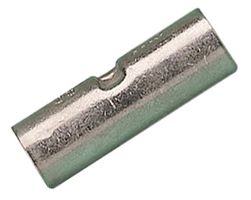
Crimp and heatshrink this
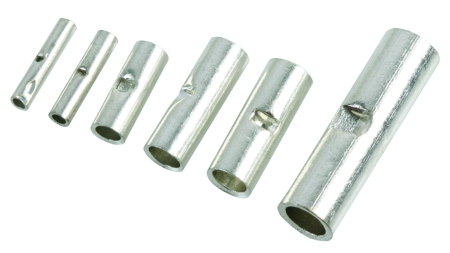
Same as top one showing different sizes
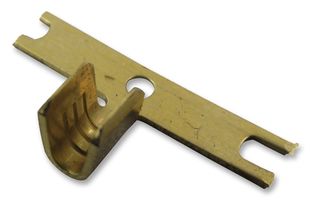
Use crimp pliers that fold the connector around the wires
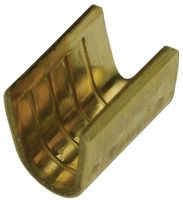
Better view of a foldable splice connector
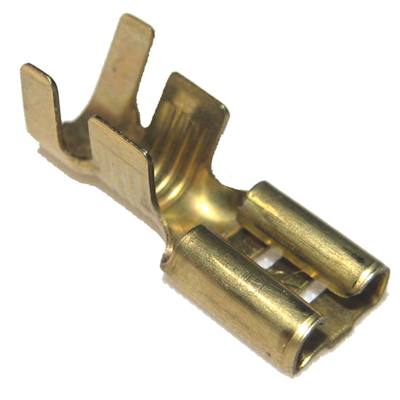
The foldable crimpable end can be cut off this terminal and used in the same way as the above 2 brass coloured connectors
THIS ABOVE ONE IS A TRADE SECRET SO KEEP IT QUIET
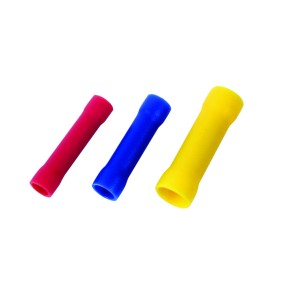
Cut the plastic off these and use the tube from inside them just like the ones in the first 2 images at the top
THIS ABOVE ONE IS A TRADE SECRET SO KEEP IT QUIET

Above is a crimped tube before being heatshrinked
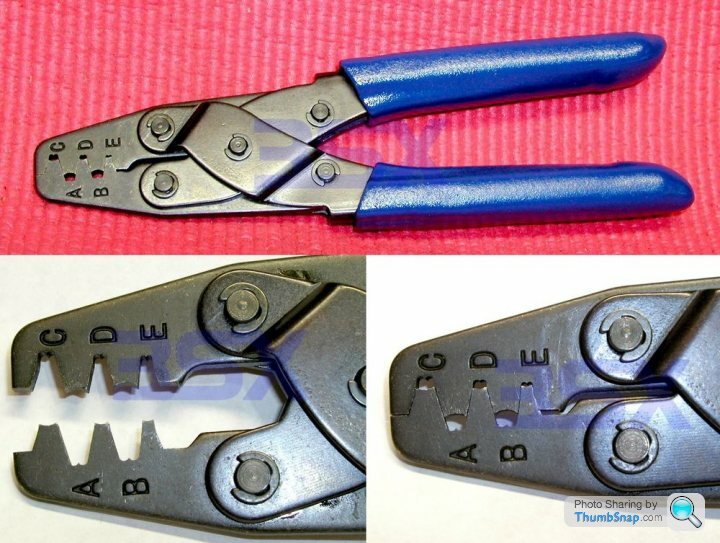
The above crimping pliers will do the foldable crimp connectors and they will also crimp a tube
Fold crimping pliers are much better than those horrible cheap and nasty ones that only crush the terminals on
Practice with different size tubes or foldables for different sized wires
Dont forget the adhesive heatshrink
The picture I used to show a soldered splice with adhesive heatshrink over it was a crimped splice with adhesive heatshrink over it, I only used the picture to show the method
There is nothing wrong with soldering wires together and then heat-shrinking them, making sure that the heatshrink is long enough to take the load off the area of wire that solder will have run along, if the wires that have been soldered and heat-shrinked are in a wiring loom they will be taped up and vibration on the soldered joints will not be a problem
For those of you that have problems with soldering, take a look at the following pictures (I will post a comment or two with them)
A google search for splice connector or butt connector may help

Crimp and heatshrink this

Same as top one showing different sizes

Use crimp pliers that fold the connector around the wires

Better view of a foldable splice connector

The foldable crimpable end can be cut off this terminal and used in the same way as the above 2 brass coloured connectors
THIS ABOVE ONE IS A TRADE SECRET SO KEEP IT QUIET

Cut the plastic off these and use the tube from inside them just like the ones in the first 2 images at the top
THIS ABOVE ONE IS A TRADE SECRET SO KEEP IT QUIET

Above is a crimped tube before being heatshrinked

The above crimping pliers will do the foldable crimp connectors and they will also crimp a tube
Fold crimping pliers are much better than those horrible cheap and nasty ones that only crush the terminals on
Practice with different size tubes or foldables for different sized wires
Dont forget the adhesive heatshrink
Edited by Penelope Stopit on Saturday 1st October 18:14
Edited by Penelope Stopit on Saturday 1st October 18:49
Gassing Station | Home Mechanics | Top of Page | What's New | My Stuff




